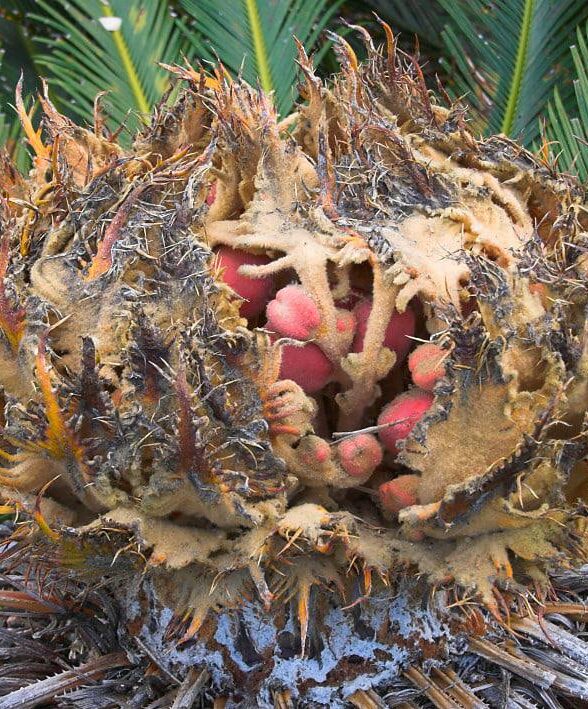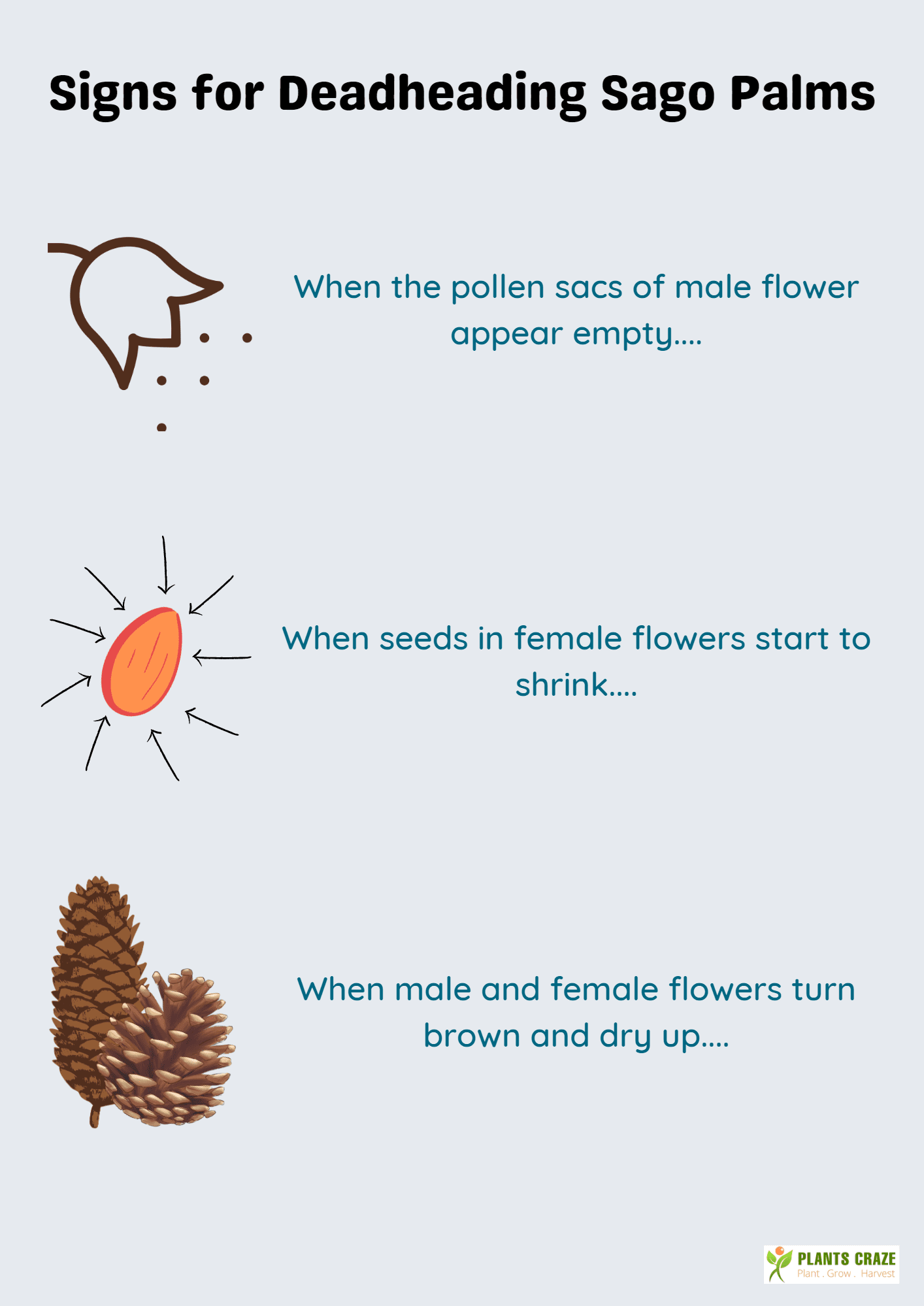Sago Palm flower has been blooming on earth since the dawn of dinosaurs, and they have changed so little that it seems like their flowers are frozen in time!
Flowers of Sago Palm are crafted naturally to suit indoor and outdoor decor with many hidden uses. So, let’s get to the article and learn more about the flowers of this ancient plant.
Table of Contents Show
How Often Does the Sago Palm Flower?
The Sago Palm flower resembles a large pinecone, but its shape differs in Male and Female plants.
In Male Sago Palm, the flower is erect and extends skywards, while the Female Sago Palm flower is more round, short and furry.
However, you can only witness the first bloom in Sago Palm after 15-20 years after the first planting.
The male flower dries within 7-14 days after maturity, while the female flower stays for a longer period of time (more than 10 months).
Sago Palm flowers bloom within zones 9-11, and you can also grow them indoors by placing them in a bright east-, west-, or south-facing window.
Sago Palm: Flower Overview
Do you know Sago Palms dominated the earth’s vegetation for 100 to 200 million years? Hence, they are also known as ‘living fossils.’
Also, Sago Palms (Cycas revoluta) are Gymnosperms belonging to the Cycadaceae family, one of the oldest plant families.
They are native to southern Japan, including the Ryukyu Islands.
For more features, look at the table to understand the flowers of Sago Palm.
| Features | Characteristics |
|---|---|
| Appearance | Male Flower: Elongated and Cone-Shaped Female Flower: Globular and Furry |
| Size | Male Flower: 50-70 centimeters long Female Flower: 30-50 centimeters long |
| Color | Yellow or Brownish Yellow |
| Fragrance | Both Male and Female Flower Produce Strong Chemical Scent During Pollination |
| Seeds | Orange to Red (approximately 3 centimeters wide and 4 centimeters long) |
| Seeds Harvesting Method | Hand Picking or Harvesting Entire Flower |
| Pollination | Wind and Insects |
| Identification | Shape of the Flower |
| Toxicity | Contains Cycasin (Harmful to Pets and Humans) |
Germination of Sago seed is tedious as they may take about 3 months to sprout.

Pollination of the Sago Palm Flower
At the time of sexual maturity, the Female Sago begins to flower, growing a basketball-sized structure, while the Male Sago produces an elongated structure.
Sago Palms can pollinate naturally with the help of specific insects and wind. But, hand pollination requires more effort.
1. Natural Pollination
Wind and Insects, especially sap beetles, are two natural agents for the pollination of the Sago Palms.
Wind pollination is only viable if female and male plants are 2 meters apart so, keep your palm couples near to ensure a successful pollination process.
During the months of pollination, male and female plants release a strong odor containing a chemical compound, Estragole, that attracts insects.
But, insect pollination is more helpful in rainy seasons, when pollen availability in the air becomes low due to the rain.
This is when the chemical power of the flowers comes in handy.

2. Hand Pollination
Hand pollination can be helpful when male and female plants are far from each other.
You can successfully perform hand pollination from April to June (late spring to early summer).
Follow the steps below to complete the successful hand pollination of the Sago Palm.
- Wait for the Female flower to open and the Male flower to produce pollen.
- After pollens appear, cut the Male flower from the base using a gardening saw.
- Take the Male flower and rub it to dust the pollen over the female flower.
Check out this video to learn more extra information about the pollination process!
It is ideal for pollinating the plant within 2 weeks, as female flowers remain receptive only for a short period of time.
How to Make a Sago Palm Plant Flower?
There are certain requirements for making a Sago Palm bloom to its fullest.
Below is a list of tips you may need to consider to grasp the flowering of Sago Palms.
- Provide Sago Palms with 4-6 hours of filtered sunshine.
- Maintain humidity levels around 40-50% by placing a humidifier near the plant or putting the plant on a pebble tray.
- Use a bloom booster right before summer, and slow-release 18-6-8 fertilizer during the growth period.
- Sago Palm grows and blooms in well-drained, sandy, and loamy soil with a 5.5–6.5 pH level.
- Water your Sago Plant every 1-2 weeks in spring and summer.
- Keep the surrounding temperatures around 15-110°F.
What Should You Do with Sago Palm Flowers?
The flowers of the Sago Palm are not as beautiful as those such as roses, lilies, or tulips.
However, deciding whether to keep or deadhead the flower is subjective.
The male flower provides pollens at maturity, while the female flower provides the plant with seeds for growing new plants.
The best use of the Sago Palm flower is its ability to deliver ornamental assurance on sidewalks and gardens.
However, cutting the flowers for some valid reasons will be beneficial.
- The flowers contain the highest levels of Cycasin, which is toxic to humans and pets.
- Sago Palm diverts the essential energy from foliage to cones and may run out of nutrition for the plant’s growth.
Besides offering seeds, there are no other reasons for keeping the flowers, and the foliage will be enough to give a beautiful vibe to the plant.
How to Cut Sago Palm Flowers?
Follow the steps to get into removing the Sago Palm flower.
- Take a saw, hold the top of the Male flower, and cut it with a saw.
- Snapping the flower directly will not cause harm if it is old and dry.
- Cut the entire flowering stalk from below for the Female flower with a saw.
Pro Tip! Empty pollen sacs in the flower suggests that the pollens are gone and the flower is ready for cutting.
Consider the following precautions to avoid harm to the plant.
- Remove the female flower before it opens, as it will be difficult to remove once it is fully blooming.
- Ensure not to cut the leaves in the process.
- Leaving the bloom alone is the best option unless you want the pollens or seeds.
- Take extra care by not letting your pets around the flowers.

Uses of Sago Palm Flowers
Though Sago Palm flowers cannot serve the ornamental value for every eye, they can offer the following benefits.
- Female flowers contain phenolic compounds effective against many bacterial and fungal infections.
- Seeds are also significant for cancer treatment and certain tumors in lab trial experiments.
- Sago starch serves culinary purposes. Also, “Date Miso” is a delicacy prepared after mixing dried powdery seeds with brown rice in Japan.
However, you should not consume the flowers or any parts of the plant directly.
Eating Sago before processing may cause vomiting, liver damage, and other fatal outcomes!
According to ASPCA, Sago Palm contains Cycasin which can be toxic to cats, dogs, and horses.
When consuming the plant, your pets may develop symptoms such as vomiting, increased thirst, bruising, and liver damage.
If any unfortunate accidents happen to you, your family member, or your pets, you can contact the helpline numbers below.
FAQs About Sago Palm Flower
Will Sago Palm Flower Grow Back?
Sago Palms are perennial plants producing new flowers every 2-3 years, but the process is gradual and slow.
Can Pets Get Sick After Sniffing Sago Plant Flower?
Parts of the Sago Palms contain Cycasin, which is toxic to pets and humans.
Sniffing a flower containing pollen may cause allergic reactions but might not be fatal.
What are the Orange or Red Balls in Sago Plant?
Orange or red balls on the Female Sago flowers are seeds formed a few months after pollination.
From Editorial Team
Use two Male flowers to Pollinate Female flowers!
If you have two Male flowers full of pollens, rub them together over the Female flower. Also, ensure that the day is sunny without any extent of rain.


